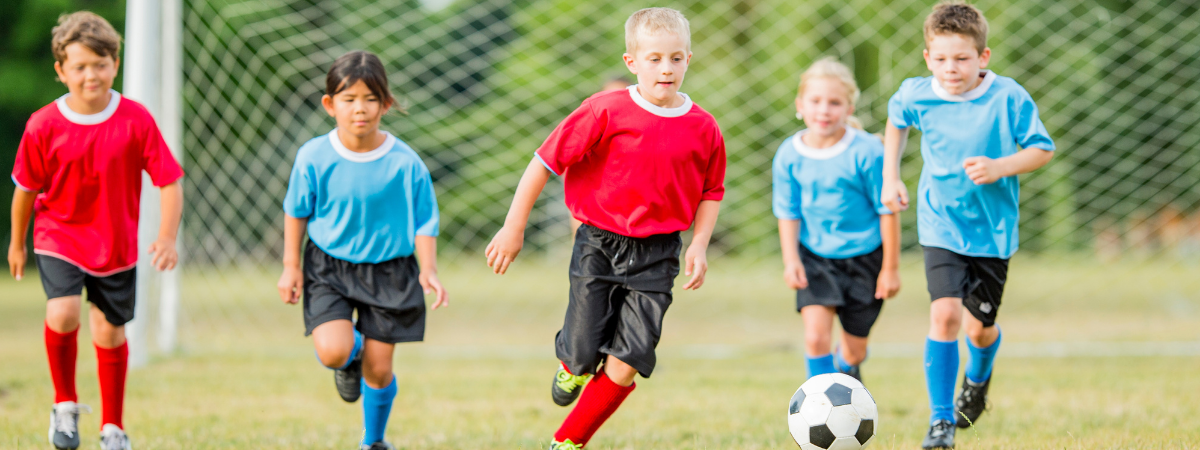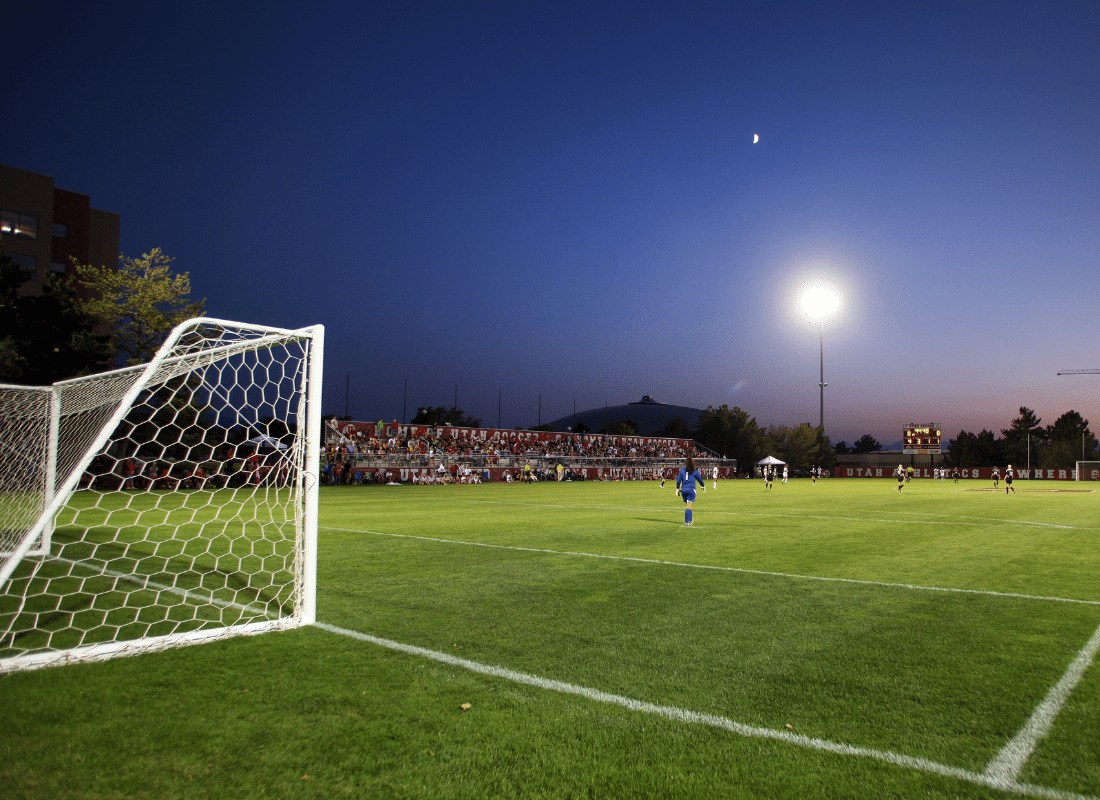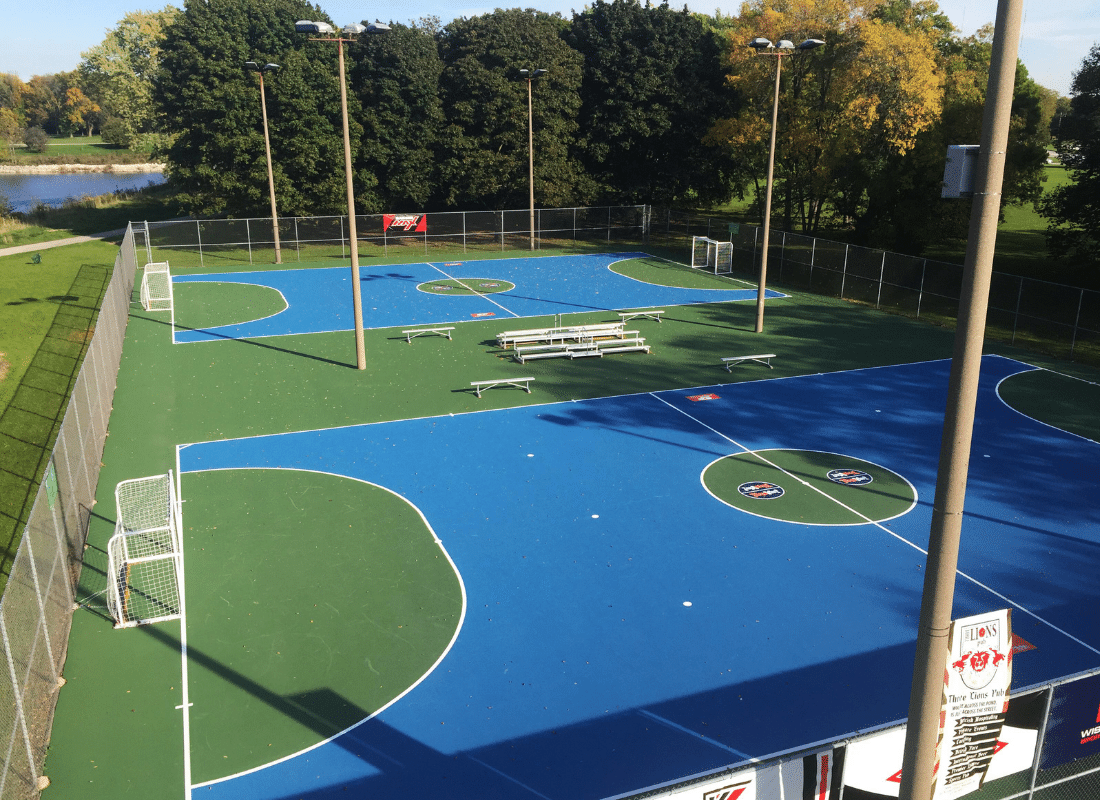The Ultimate Guide To U.S. Soccer Goal Dimensions & Material Requirements (2024)
Soccer Goal Size and Material Requirements For Soccer Goals For Soccer Organizations In the United States

IN THIS ARTICLE
Soccer goals come in many different dimensions depending on the age or the need (practice, games, backyard, futsal, etc.). As a new employee in the sporting equipment industry, I get a headache trying to figure out which size soccer goal to recommend to a coach, club, or school because there are so many options.
And to make it even more confusing the various soccer organizations in the United States have different requirements and recommendations for the dimensions and requirements for soccer goals for our youth.
Don’t have time to read all the specifics? Check out our Soccer Goal Size Chart to get the basics on soccer goal size for some of the largest organizations in the United States. Always be sure to check with your specific league to confirm the soccer goal size requirements before purchasing soccer goals.
Read on if you’d like to take a deeper dive into the various soccer organizations’ rules and regulations regarding soccer goal material and size requirements. I’ll focus on the following organizations:
| Organization | Audience/Leagues |
|---|---|
| FIFA (International Federation of Association Football) | US Soccer, International Organizations, MLS, NWSL, USL |
| NCAA (National Collegiate Athletic Association) | NCAA DI, DII and DIII men’s and women’s college soccer teams |
| NFHS (National Federation High School) | Boys and girls high school soccer teams in the United States |
| US Youth Soccer | Various member club soccer teams in the United States |
| AYSO (American Youth Soccer Organization) | AYSO member youth soccer teams in the United States |
| MASL (Major Arena Soccer League) | Professional arena soccer league of North America |

FIFA
International Federation of Association Football (FIFA) is an international governing body of associations, including football, futsal, beach soccer, and eFootball. FIFA supports the highest form of soccer in the world, and most professional leagues will do their best to replicate the rules of FIFA for adult-level players.
Goals are addressed in FIFA’s Laws of the Game in Law 1: The Field of Play:
10. Goals
A goal must be placed on the centre of each goal line.
A goal consists of two vertical posts equidistant from the corner flagposts and joined at the top by a horizontal crossbar. The goalposts and crossbar must be made of approved material and must not be dangerous. The goalposts and crossbar of both goals must be the same shape, which must be square, rectangular, round, elliptical or a hybrid of these options.
It is recommended that all goals used in an official competition organised under the auspices of FIFA or confederations meet the requirements of the FIFA Quality Programme for Football Goals.
The distance between the inside of the posts is 7.32 m (8 yds) and the distance from the lower edge of the crossbar to the ground is 2.44 m (8 ft). The position of the goalposts in relation to the goal line must be in accordance with the graphics. See graphic on page 37 of the 2023/2024 FIFA Laws of the Game. The goalposts and the crossbar must be white and have the same width and depth, which must not exceed 12 cm (5 ins).
If the crossbar becomes displaced or broken, play is stopped until it has been repaired or replaced in position. Play is restarted with a dropped ball. If it cannot be repaired the match must be abandoned. A rope or any flexible or dangerous material may not replace the crossbar.
Nets may be attached to the goals and the ground behind the goal; they must be properly supported and must not interfere with the goalkeeper.
Safety
Goals (including portable goals) must be firmly secured to the ground.
Download the FIFA Laws of the Game 2023-24
Order a copy of the 2023-2024 FIFA Laws of the Game
FIFA FUTSAL
Futsal has been a sport played in Europe and other countries for a long time, but over the past 5 years has grown more and more in the U.S. Part of its growing popularity is due to the increased skill development that takes place from this version of indoor soccer. Two critical differences of what is required in a futsal goal compared to an outdoor goal are:
- The dimensions of the goal are smaller in futsal.
- Futsal goalposts and crossbars must be of a different color from the pitch.

The following is how FIFA officially defines futsal goals in its FIFA Futsal Laws of the Game 22/23 rule book (p.18):
“A goal must be placed on the center of each goal line. A goal consists of two upright posts equidistant from the corners and joined at the top by a horizontal crossbar. The goalposts and crossbar must be made of wood, metal or other approved material. They must be square, rectangular, round or elliptical in shape and must not be dangerous to players. The distance (inside measurement) between the posts is 3m and the distance from the lower edge of the crossbar to the ground is 2m. Both goalposts and the crossbar have the same width and depth, 8cm. The nets must be made of hemp, jute or nylon or other approved material and are attached to the back of the goalposts and the crossbar with a suitable means of support. They must be properly supported and must not interfere with the goalkeeper. The goalposts and crossbars must be of a different color from the pitch. Goals must have a stabilising system that prevents them from overturning. They must not be fixed to the ground, but must have an adequate weight at the back so as to allow the goalposts to move reasonably without endangering the safety of the participants. Portable goals may only be used if they satisfy this requirement.”
- Note: This is the most recent version of the rulebook we can find published online as of Jan. 27, 2024. We will update when a new version becomes available.
For more information on Futsal check out Futsal: FIFA’s Development Programmes and Guidelines
NCAA
The National Collegiate Athletic Association (NCAA) comprises legislative bodies (volunteers from member schools that govern each division). The committees are in charge of managing many different topics, including sports rules.
In College soccer, the definition of a soccer goal is straightforward. However, they do emphasize in their rules what happens if a ref finds a goal that does not meet their rules, highlighted in bold below. Make sure you have a strong goal (see Keeper Goals strong welded goals) because if you don’t and a Crossbar or Goal Post is displaced, the game will be suspended until fixed (see rule1.11)
The NCAA Soccer Rules and Interpretations Book, Rule 1.9, (Goals) states:
The goals shall be anchored, secured or counterweighted. The goal posts, which shall be superimposed on end lines of the same width and depth, shall consist of two posts, equidistant from the corner flags and 8 yards apart (inside measurement), joined by a horizontal crossbar of similar material, the lower edge of which shall be 8 feet from the ground. Note: If the above cannot be corrected before the start of competition, the game shall not begin and the referee shall file a report with the governing sports authority.”
The width or diameter of the goalposts and crossbar shall not be less than 4 inches nor more than 5 inches, and the same width as the goal line. The back edge of the goal post must align with the outermost edge of the end line. The posts and crossbar may be square, rectangular, round or elliptical in shape, and shall be painted white. In addition, no markings other than a single manufacturer’s identification/logo of appropriate size may appear on the goalposts or the crossbar. Note: If any of these cannot be corrected before the start of competition, the game shall begin and the referee shall file a report with the governing sports authority.”
Order the 2022-23 NCAA Soccer Rulebook or download the free pdf version
- Note: As of January 2024, the 2022-23 NCAA Soccer Rulebook is the most recent edition. We will update to the 2023-24 version when available.
NFHS
The National Federation of High Schools (NFHS) is the organization that writes the rules of competitions for most high school sports and activities in the US. In total, approximately 19,500 high schools belong to associations that are members of the NFHS. The NFHS publishes rule books for soccer that have similar rules to the NCAA that were previously stated; however, it has additional rules when putting a goal on a field with football goalposts. Many high school fields have this issue and can cause much confusion for high school soccer coaches. As a result, when looking for the right soccer goal that will be compliant with NFHS rules on a football/soccer field make sure you know the following measurements on your field:
- The distance from the bottom football goal post to the soccer goal line
- The overhang of the football goal post (distance from bottom goal post to football crossbar)
If you know the above information, then if you call a goal manufacturer, they will be able to provide you with compliant soccer goals that meet NFHS standards. Below is a picture of a goal that has been custom-made on the bottom back base bar to go around a field goal post.
If you are a high school soccer coach, make sure you follow the below rules for the goals you use on your field;
The NFHS rule book (rule 1, section 4, article 1) states:
The goals shall be placed on the goal line. They shall consist of two upright posts between 4 inches and 5 inches in projected diameter placed an equal distance from the corner flags and 8 yards apart (inside measurement). The rear of each goal post shall be on the outer edge of the goal line. The tops of the posts shall be joined by a 4-inch, but not more than 5-inch horizontal crossbar, the lower edge of which shall be 8 feet from the ground. Soccer goals shall be white. No markings other than a single manufacturer’s identification/logo may appear on the goal posts or crossbar.
Metal pipes of 3 to 4 inches in diameter may be used. If portable goals are used, they shall be adequately anchored, secured or counterweighted to the ground. If used on a football field, the front of the portable goals should be at least 2 yards in front of the base of the existing football goalposts.
The vertical portion of the soccer goal post may be padded with commercially manufactured material for soccer goals. This material shall be white, have a maximum thickness of one inch, be a minimum of 72 inches high and shall be properly secured. No markings other than a single manufacturer’s identification/logo may appear on the goal post padding.
Order the 2023-24 NFHS Soccer Rules Book
US Youth Soccer
US Youth Soccer is a member of US Soccer and also a member of FIFA, which serves as the international governing body for soccer. US Soccer has been a member of FIFA since 1913. US Youth Soccer makes its recommendations for goal sizes based on US Soccer’s Small-Sided Games Chart, which shows the maximum size that can be used for ages U6-U12. Teams/clubs should not exceed the maximum standard for goal size that has been set forth by US Soccer. U13 and older would use standard 8’ h x 24’ w goals.
US Youth Soccer allows some concessions and says recommended goal sizes may be changed slightly to utilize the field best as long as it does not affect the quality of soccer.
Recommended Maximum Goal Sizes For US Youth Soccer are;
- U6, U7, U8 – Maximum recommended soccer goal size is 4′ x 6′
- U9, U10 – Maximum recommended soccer goal size is 6’6″ x 18’6″
- U11, U12 – Maximum recommended soccer goal size is 7′ x 21′
- U13 and up – Maximum recommended soccer goal size is 8′ x 24′
See US Youth Soccer’s web page listing recommended maximum soccer goal sizes
AYSO
The American Youth Soccer Association (AYSO) is a non-profit organization and the oldest national youth soccer program in the United States. They have a national office in Torrance, California, and divide their organization by Regions, Areas, and Sections where they have volunteers directing these programs. IFAB Laws govern AYSO.
Maximum and Recommended Soccer Goal Sizes For AYSO as stated on the AYSO’s Small-Sided Games Document on the AYSO website;
- U6, U7, U8 – Maximum soccer goal size is 4′ x 6′
- U9, U10 – Maximum soccer goal size is 6’6″ x 18’6″ and recommended soccer goal size is 6’6″ x 12′
- U11, U12 – Maximum soccer goal size is 7′ x 21′ and recommended soccer goal size is 6’6″ x 18’6″
Download the AYSO Small-Sided Games Document on the AYSO website
Visit the Refereeing Section of the AYSO website to learn more about AYSO rules
MASL (Major Arena Soccer League)
The MASL website states,
The Major Arena Soccer League represents the highest level of professional arena soccer in the world. The MASL features teams across North America, with teams playing coast-to-coast in the United States, Canada and Mexico. The MASL is currently incorporated as a 501(c)6 not for profit corporation formed to promote the business and sport of arena soccer.
Section 1.8 (page 7) of the 2023-2024 MASL rulebook addresses the goals and says;
The goals shall be placed on the center of each goal line within the perimeter wall and shall consist of two (2) upright posts, equidistant from the corner flags and fourteen feet (14’) apart (inside measurement), joined by a horizontal crossbar, the lower edge of which shall be eight feet (8’) from the surface of the carpet. The width and depth of the goalposts and crossbars shall not be less than four inches (4”) nor exceed five inches (5”). The goalposts, crossbar and goal line shall have the same width. Nets shall be attached to the posts, crossbars and to the ground behind the goals. They should be appropriately supported and be so placed as to allow the goalkeeper ample room. The depth of the goal net shall be a minimum of five feet (5’). The goal post and crossbar shall be red in color.
You may download the complete 2023-24 MASL rulebook here.
Blind Football
The International Blind Sports Federation Blind Football Laws 2022-2025 rulebook addresses the goals and goal safety on pages 7-8 saying;
The goals must be white and they must be placed at the centre of each goal line. They consist of two upright posts equidistant from each corner and joined at the top by a horizontal crossbar. The distance (inside measurement) between the posts is three sixty-six meters (3.66m) and the distance from the lower edge of the crossbar to the ground is two and fourteen metres (2.14m).
Both goal posts and the crossbar have the same width and depths of 8cm. Nets, made of hemp, jute or nylon, are attached to the posts and crossbar behind the goals. The lower part is supported by curved bars or another form of adequate support. The depth of the goal, described as the distance from the inside edge of the goal posts towards the outside of the pitch, is at least 80 centimeters at the top and 100 centimeters at ground level.
The goals may be portable but they must be anchored securely to the ground during play. For the players’ safety, the minimum distance between the goal lines and any obstacle is 2 (two) meters. If this is not possible, any obstacle in the zone should be made safe to protect the players.
Our Favorite Soccer Goals
Check out some of our favorite 4′ x 6′, 6’6″ x 18’6″, 7′ x 21′ and 8′ x 24′ soccer goals.
| 4′ x 6′ | 6’6″ x 18’6″ | 7′ x 21′ | 8′ x 24” |
|---|---|---|---|
| Folding Aluminum Soccer Goals | Ultimate Wheeled Soccer Goals (Rectangular Posts) | Elite Soccer Goals (Cable Net Attachment) | Box-style Soccer Goals With Wheels |


